
ELECTRICAL WIRING:RESIDENTAL-6 PLANS
18th Edition
ISBN: 9781305098329
Author: MULLIN
Publisher: CENGAGE L
expand_more
expand_more
format_list_bulleted
Concept explainers
Textbook Question
Chapter 17, Problem 7R
Where in the NEC would you look for the installation requirements regarding flush and recessed lighting luminaires?
Expert Solution & Answer
Trending nowThis is a popular solution!

Students have asked these similar questions
Question One
R
C
ww
(t)T
Figure 2: R-C Circuit
A series R-C circuit in figure 2, has a step input voltage applied to it. Use Laplace transforms
to determine expressions for
(a) Current, i(t) flowing in the circuit, given that when t = Os, i=0A [12 marks]
(b) Use the expression obtained in (a), calculate the current i(t) flowing in the circuit,
when V = 15volts, R = 50, C=1F, t = 1sec
[2 marks]
7. MOSFET circuit
The MOSFET in the circuit below has V₁ = 1 V and kn = 4 mA/V².
a) Is the MOSFET operating in saturation or in the triode region?
b) Determine the drain current ID and Vout.
+ 5 V
5 k
Vout
Not use ai please
Chapter 17 Solutions
ELECTRICAL WIRING:RESIDENTAL-6 PLANS
Ch. 17 - What is the total current draw when all six...Ch. 17 - The junction box that will be installed above the...Ch. 17 - Why is it important that the hot conductor in a...Ch. 17 - In the diagram, Load A is rated at 10 amperes, 120...Ch. 17 - Calculate the watts loss and voltage drop in each...Ch. 17 - Unless specifically designed, all recessed...Ch. 17 - Where in the NEC would you look for the...Ch. 17 - What is the current draw of the recessed...Ch. 17 - Prob. 9RCh. 17 - Calculate the total current draw for Circuit B9,...
Knowledge Booster
Learn more about
Need a deep-dive on the concept behind this application? Look no further. Learn more about this topic, electrical-engineering and related others by exploring similar questions and additional content below.Similar questions
- 5. MOSFET circuit The MOSFET in the circuit below has Vt = 0.5 V and kn = 0.4 mA/V2. Determine Vout. + 5 V 1 mA - Vout 6. MOSFET circuit The MOSFET in the circuit below has V₁ = 1 V and kn = 2 mA/V². a) Is the MOSFET operating in saturation or in the triode region? b) Determine the drain current ID. +2V 2 V -2 Varrow_forwardPlease show formula used and steps as I will study themarrow_forwardplease answer question below thxarrow_forward
- Question 1: Answer A, 6EH is wrong Question 7: Answer D is wrongarrow_forwardA.With the aid of a diagram, describe fringing, and explain the impact that it has on the relevant magnetic circuit parameter. B. A coil of 1500 turns give rise to a magnetic flux of 2.5 mWb when carrying a certain current. If this current is reversed in 0.2 s, what is the average value of the e.m.f. induced in the coil? C.Define Mutual Inductance.Two coils are connected in series and their total inductance is measured as 0.12 H, and when the connection to one coil is reversed, the total inductance is measured as 0.04 H. If the coefficient of coupling is 0.8, determine:The self-inductance of each coil, and the mutual inductance between the coils.arrow_forwardcomparing Lenz's law and the left hand generator rule, which of these is the more important fundamental principle?arrow_forward
- Example: Electric Field and Potential Inside a Charged Sphere Problem: A sphere of radius R = 0.2 m is uniformly charged with a total charge Q = 5 μC. The sphere is made of a dielectric material with relative permittivity € = 4. Calculate: 1. The electric field intensity E(r) inside and outside the sphere. 2. The electric potential (r) at any point inside the sphere. Solution: Step 1: Given Data Radius of the sphere: R = 0.2m, Total charge: Q-5 μC=5× 10° C. Step 2: Electric Field Inside the Sphere (< Using Gauss's Law:arrow_forwardplease remember to draw the circuitsarrow_forwardA balanced three-phase, A - connected induction motor consumes 3246 W when the l voltage is 208 V, and the line current is 10.6 A. Calculate: i. The motor's winding resistance. ii. The motor's winding reactance. 12 marrow_forwardarrow_back_iosSEE MORE QUESTIONSarrow_forward_ios
Recommended textbooks for you
 EBK ELECTRICAL WIRING RESIDENTIALElectrical EngineeringISBN:9781337516549Author:SimmonsPublisher:CENGAGE LEARNING - CONSIGNMENT
EBK ELECTRICAL WIRING RESIDENTIALElectrical EngineeringISBN:9781337516549Author:SimmonsPublisher:CENGAGE LEARNING - CONSIGNMENT Electricity for Refrigeration, Heating, and Air C...Mechanical EngineeringISBN:9781337399128Author:Russell E. SmithPublisher:Cengage Learning
Electricity for Refrigeration, Heating, and Air C...Mechanical EngineeringISBN:9781337399128Author:Russell E. SmithPublisher:Cengage Learning

EBK ELECTRICAL WIRING RESIDENTIAL
Electrical Engineering
ISBN:9781337516549
Author:Simmons
Publisher:CENGAGE LEARNING - CONSIGNMENT

Electricity for Refrigeration, Heating, and Air C...
Mechanical Engineering
ISBN:9781337399128
Author:Russell E. Smith
Publisher:Cengage Learning
What is an electric furnace and how does it work?; Author: Fire & Ice Heating and Air Conditioning Inc;https://www.youtube.com/watch?v=wjAWecPGi0M;License: Standard Youtube License